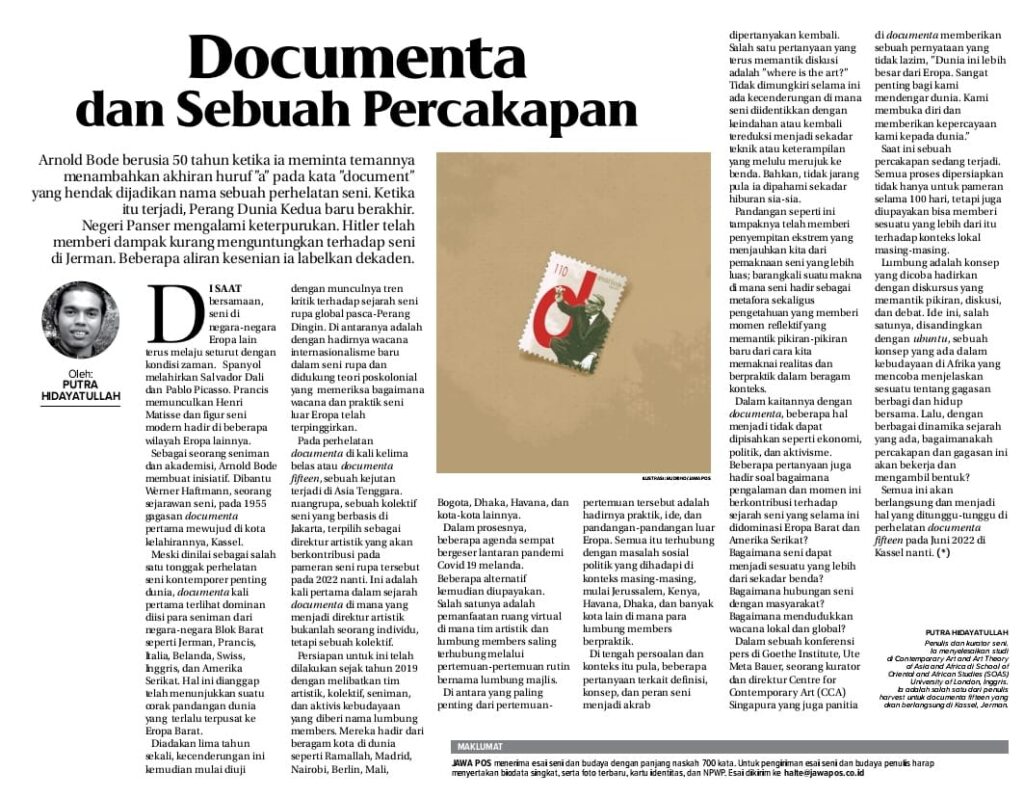By Putra Hidayatullah

Arnold Bode was 50 years old when he requested a colleague to add the letter “a” at the end of the word “document” to name an art event. When this happened, the Second World War had just ended. The war had also deeply affected the art scene in Germany. Previously, in July 1937, there was the National Socialist propaganda exhibition “Entartete Kunst” in Munich. The show was accompanied by defamatory, anti-Semitic and anti-communist statements under the Nazi catchphrase “Jewish-Bolshevik art”. The label “degenerate art” was applied to denounce modern art, such as Cubism, Expressionism, and Dadaism, from social and cultural life because it was considered “un-German”.
At the same time, in other European countries, art continued to progress according to the conditions of the times. Spain gave birth to Salvador Dali and Pablo Picasso. France gave rise to Henri Matisse and modern art figures appeared in several other parts of Europe.
As an artist and academic, Arnold Bode took the initiative. Assisted by the art historian Werner Haftmann, in 1955 the idea of documenta first materialized in his hometown, Kassel. Werner Haftmann was a member of the SA and a member of the NSDAP, which had direct consequences for the documenta program. Not only were no works about the violent crimes of the Nazis shown, even art by Nazi victims who had directly experienced this violence had not been presented.
Even though it is considered as one of the milestones in the world’s important contemporary art event, first documenta exhibition appeared to be dominated by artists from Western Bloc countries such as Germany, France, Italy, the Netherlands, Switzerland, England, and the United States. This is considered to have shown a pattern of the worldview that is too focused on Western Europe.
Being held every five years, this trend is then tested with the emergence of criticism of the post-cold war global art history. Among them is the presence of a new internationalism discourse in art and the support of postcolonial theory which examines how non-European art discourses and practices have been marginalized.
At the fifteenth documenta event or documenta fifteen, a surprise occurred in Southeast Asia. ruangrupa, an art collective based in Jakarta, was selected as the artistic director that will contribute to the art exhibition in 2022. This is the first time in documenta’s history that the artistic director is not an individual, yet a collective.
Preparations for this event have been carried out since 2019 by involving an artistic team, collective, artists, and cultural activists named the lumbung members. They come from various cities in the world such as Ramallah, Madrid, Nairobi, Berlin, Mali, Bogota, Dhaka, Havana, and other cities.
In the process, several agendas were shifted due to the Covid-19 pandemic. Several alternatives were then attempted. One of them is the use of virtual space where the artistic team and lumbung members are connected to each other through regular meetings called lumbung majelis.
Among the most important of these meetings was the presence of practices, ideas and views beyond Europe. All of these are connected with socio-political problems faced in their respective contexts, ranging from Jerusalem, Kenya, Havana, Dhaka, and many other cities where lumbung members practice.
In the midst of these issues and contexts, several questions related to the definition, concept, and role of art have been part of the conversations. One of the questions that continues to spark discussion is “where is the art?” It is undeniable that all this time there has been a tendency where art is identified with beauty or is reduced to just a technique or skill that only refers to objects. In fact, not infrequently it is also understood as just a futile entertainment.
This kind of view seems to have given an extreme simplification that distances us from the broader meaning of art; perhaps a meaning in which art presents as a metaphor as well as knowledge that provides a reflective moment that ignites new thoughts from the way we interpret reality and practice in various contexts.
In relation to documenta, several things become inseparable, such as economics, politics, and activism. Several questions were also asked about how these experiences and moments contributed to the history of art, which has been dominated by Western Europe and the United States. How can art be something more than just an object? How is the relationship between art and society? How to place local and global discourse?
At a press conference at the Goethe Institute, Ute Meta Bauer, an art curator and director of the Singapore Center for Contemporary Art (CCA) who is also a committee member at documenta, made an unusual statement, “The world is bigger than Europe. It is very important for us to listen to the world. We are opening up and putting our trust in the world.”
Currently a conversation is taking place. All processes are prepared not only for the 100-day exhibition, but also strive to give something more to their respective local contexts.
Lumbung is a concept with a discourse that ignites thoughts, discussions and debates. This idea, for one, is paralleled with ubuntu, a concept that exists in African cultures that tries to articulate something about the idea of sharing and living together. Then, given the various historical dynamics that exist, how will these conversations and ideas work and take shape?
All of this will take place and will be something to look forward to at the documenta fifteen in June 2022 in Kassel. []
Putra Hidayatullah is a writer and art curator. He completed his studies in Contemporary Art and Art Theory of Asia and Africa at the School of Oriental and African Studies (SOAS) University of London, UK. He is one of the co-authors of harvest for documenta fifteen which will take place in Kassel, Germany.
NB:
This essay has previously been published in Bahasa Indonesia by Jawa Pos
